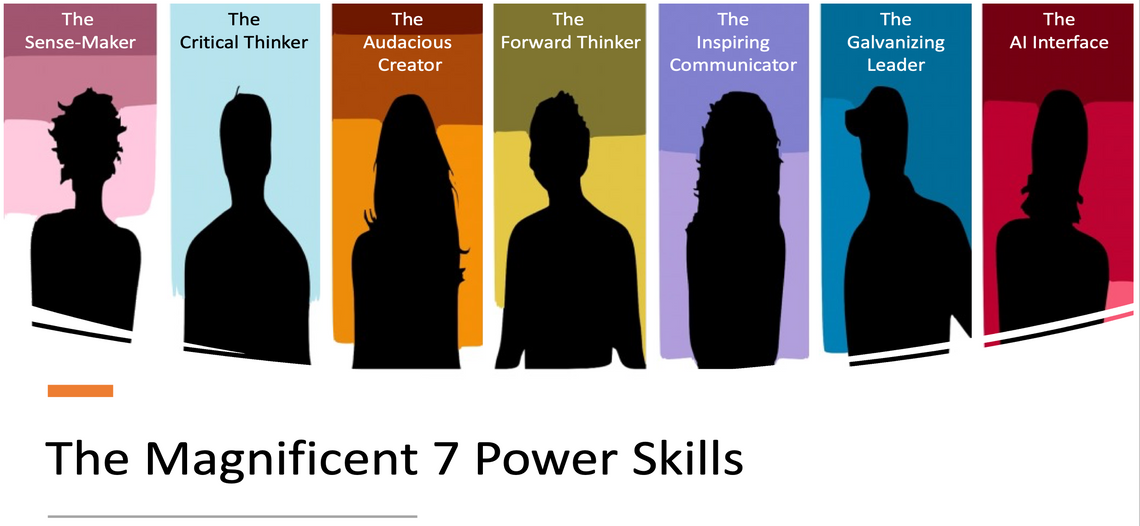Winners and losers in the game of AI-Workplace 'Snakes & Ladders' Part 2
Now we look into Aldous Huxley’s Brave New World's six social strata. We have called these the Billionaires’ Club, New Tech Entrepreneurs, the Newly Advantaged, the Newly Disadvantaged, White-collar Drones and the Dispossessed.

Article series
AI-Workplace 'Snakes & Ladders'
- Winners and losers in the game of AI-Workplace 'Snakes & Ladders' Part 1
- Winners and losers in the game of AI-Workplace 'Snakes & Ladders' Part 2
In the first part of this article, we reviewed the opportunities and threats posed by AI and argued that it would be helpful to set up a ‘strawman’ structure to reflect how AI might shape the world of knowledge work in the future – a framework to be knocked down and discussed.
Specifically, we set up the idea – borrowing from Aldous Huxley’s Brave New World - of there being six social strata. We have called these the Billionaires’ Club, New Tech Entrepreneurs, the Newly Advantaged, the Newly Disadvantaged, White-collar Drones and the Dispossessed.
Now, in Part Two of this article, we look at each of these in detail.
But first, some context. Of the 3.4 billion people employed globally, it is believed that about 1 billion (~30%) are knowledge workers.[1]
We should explain that, in arriving at our ‘guesstimates’ about the proportion of knowledge workers falling into each of our categories, in describing the potential quantum for each stratum, we have taken the US as an illustration of a developed market.
Of the 168m people in the labour force, it is estimated that knowledge work accounts for 60%, i.e. 100 million workers in the US. For the sake of argument, these percentages are roughly applicable to a typically developed economy.
The Alphas: The billionaires club
It seems reasonable to argue that the arrival of AI will increase the number of the uberwealthy. These are individuals who have attracted two-thirds of all the new world wealth that has been created since 2020. A 2021 Oxfam report found that collectively, the 10 richest men in the world owned more than the combined wealth of the bottom 3.1 billion people, almost half of the entire world population.
These are people who, given their bandwidth, access to technology, ability to raise finance and networking capabilities, have been able to attract the kind of wealth that leaves the rest of us trailing in their wake. The Carnegie and Rockefellers of the 1900s have been replaced by Altman, Bezos, Musk, Hassabis, et al., who lead a phalanx of AI entrepreneurs and perhaps less well-known (but no less powerful) venture capitalist investors such as Khosla, Thiel and Masayoshi Son. These are the people who control the capital and the core tools of the AI economy – they control the game board.
How big is this cohort? In truth, it is tiny – probably a few thousand people globally – but they will play an outsized role in defining the future AI-shaped workplace.
The Betas: The new tech entrepreneurs
This group will take the tools provided by the Alphas and find novel and creative ways to apply them – from personalised learning to personalised shopping, from disease detection and diagnosis to drug discovery, from identifying exoplanets to locating merging galaxies. The length and breadth of potential applications are near limitless.
And while many developers will be employed by Google, Amazon, Microsoft, IBM, etc., there is a huge opportunity for the entrepreneurially minded (from any demographic) to develop successful applications across the board. We believe that the widespread roll-out and availability of generative AI models has unleashed a wave of developmental creativity.
In addition to developing AI applications, the deployment of AI tools lowers the entry barrier to broader tech ventures. In a July 2023 Forbes article, Alex Gudilko of AJProTech LLC suggested that, from an investment standpoint, AI changes venture startup dynamics. Previously, to create a mobile app, startups needed five to 10 people and more than $500,000 in seed capital. With AI tools writing code, a team of just one or two people with $20,000 could launch a similar app in weeks. It has never been easier to start a business—even for non-technical founders![2]
Big rewards will flow to these AI entrepreneurs. While we as yet have no way of accurately gauging the incidence of Betas, in this scenario, we will assume that they represent 2% of knowledge workers or 2 million individuals in the US.
Does 2 million seem reasonable? Let’s get a rough calibration. The US had 13.6m millionaires in 2016 rising to 24.5m in 2022 [3]. A growth of 80%. A 2016 report into philanthropy in Silicon Valley [4] suggested that there were 76,000 millionaires or billionaires in San Mateo and Santa Clara counties in 2016. This is likely to be ‘tech money’. Assuming the same national growth rate, in 2023, this would equate to approximately 137,000 millionaires in these 2 counties alone… Furthermore, the growth in tech wealth is likely to outstrip the national average. A Beta, of course, doesn’t necessarily equate to a ‘millionaire’, but they will be doing nicely.
The Gammas: The newly advantaged
What we’re learning is that AI could throw up some unexpected quirky outcomes when it comes to predicting who will be the job winners and losers.
We understand that data scientists or data engineers will have a key role to play in this new world, and we are hopefully getting familiar with the role of ‘prompt engineers’. Forbes’ Technology Council also gave us other new or enhanced AI roles that include AI Trainer and Operator, Sentiment Analyzer, AI-Generated Work Auditor, AI Output Verifier, AI Prediction Analyzer, AI Input And Output Manager, AI Integration Specialist, AI Compliance Manager, AI Ethicist, VR Experience Designer, Language Ingestion Optimizer, AI Personality Designer and AI Security Engineer etc.
In addition to the new roles created, there will also be existing knowledge workers who get to leverage new AI tools to their advantage. We have listened to senior lawyers (for example) who see AI tools playing a big but compartmentalised role in their businesses, believing that their own creativity, analytical and interpretative skills will always be required to work alongside any AI system.
We have also seen it argued that AI will open up opportunities for those who have hitherto been ‘structurally and creatively oppressed’ by our educational system and the way the world of work up to now has undervalued their particular talents. These individuals have now come to the fore because they offer things that AI struggles with. They have dominant right-brain creativity, outside-the-box thinking skills, heightened sensitivity and an ability to deal with complexity in an innovative and compassionate way.
And there is evidence beginning to emerge to support this thesis. Mohammed Hossein Jarrahi‘s research on AI and the future of work tells us that AI produces a levelling up effect whereby less experienced and less skilled - previously more marginalised workers with access now to new AI tools - find themselves being catapulted up the traditional career ladder.
So, this is a welcome shot in the arm for those who hitherto felt their skills and mindset did not fit the conventional educational and work paradigm.
It is difficult to pin down what percentage of the workforce will fall into this category of AI winners. But for the sake of argument, we shall say this could be as high as 10% to 20% of the workforce – that is to say, 10 to 20 million US workers will have their positions enhanced by AI.
The Deltas: The newly disadvantaged
And now we come to our problem children. These are likely to be relative losers in an AI era. As the democratisation and levelling up of core knowledge and key skills take hold, they find themselves at a comparative disadvantage. Here, we find many who, up to now, given their education and skills, have thought that there was a comparatively secure career ahead of them. But their world is likely to be turned upside down sometime in the next three to five years. They could be shown the door or asked to take a pay cut.
As Erik Brynjolfsson points out, highly skilled workers may have less to gain from working alongside AI precisely because AI has been good at capturing the knowledge embodied in their own behaviours. In other words, AI has quickly got the number of those doing solid but not exceptional level work, encoded it, put it into AI systems and said (in the words of Douglas Adams), ‘Farewell and thanks for all the fish!’
This is a difficult pill for many people to swallow. So, if you’re going into the law, you know that judges at the very top of the tree are likely to survive being substituted by AI. But if you are a paralegal, much of what you do could be mastered by AI.
And if you are an advertising copywriter, you’re going to need to be a pretty damn good one. These days, the average comes for free, so you need to be at the top of your game. You will need to be someone who can provide audacious creativity that is going to beat what AI will be able to do.
So, if you are a senior manager in a company, your personality and leadership will still be needed - something that AI can’t readily provide. But large swathes of what you are getting the big bucks for - all the stuff you learnt on that now outdated MBA - will now easily be knocked off by AI. So, it looks like there is some downgrading of status and rewards for many. And the challenge we face with the Gammas is the sheer scale of the number of people likely to fall into this category.
In the UK, over the last few decades, we have massively built up the expectations of the Gammas. In a short space of time, we have increased the proportion of the school cohort that goes to university to 50% and then awarded over 80% of these graduates with a 2/ 1 or First class degree. We have created a massive expectation that higher education is the route to a rewarding and well-paid career.
Let us hope that AI, in generating new jobs and boosting productivity, will be able to float a lot of career boats, but the jury is still out. So, what proportion of the workforce do we feel will fall into the Gamma category over the next five years?
This is scary, and we don’t advance this figure with any relish. But, we could have as many as 30% to 40% of US knowledge workers feeling that their careers are not living up to expectations. They could become frustrated by the subordinate role they now have to play in the new AI era - and are beginning to regret the educational choices they made earlier.
The Epsilons: The white-collar drones
In this scenario, we also assume that there will be a cohort of corporate drones doing work that hasn’t been taken over by AI – but of low enough cost not to attract the spotlight of corporate efficiency hawks.
Here, we find those for whom the debate about AI taking away a rewarding career and messing up their expectations of working life is all pretty academic. Why? Because they saw the writing on the wall about the future of work a while back and have already sort of given up on the idea of building a traditional career. They are happy to coast their way through the new world of work. It’s about getting through the day with some help from AI if it’s there, and I hope you can hang onto your job.
If not, no problem. You can just pop over to another job that still needs some human input. This trend seems to be telling us that more people are looking for self-actualisation and ways of expressing themselves outside of the classic work environment.
In the history of mass production, we seem to have come full circle. We began with boring assembly line processes. We then moved to an enlightened era where, for example, car manufacturers deliberately built into their processes job-enriching activities that could cost the company time and money but were seen as warranted in order to boost the morale of employees.
And now we are into Bezosism, where the process comes first, and humans just have to suck it up and fit in around it. And it seems that many are settling for this new model. Ironically, fulfilment for many is their job function but not their route to self-actualisation!
In this scenario, considering what the structure of work might look like five years out, let’s say we could have between 10% and 20% of knowledge workers in this category.
The Zetas: The dispossessed
We’re all hoping that AI can boost output and productivity and that the proportion of individuals who just cannot compete in our highly competitive, technological AI world is kept to an absolute minimum. But let’s be realistic. The evidence tells us that there will be those who will get completely detached from the workforce and will need help.
When discussing the existential challenges of AI, issues such as ‘Will it take over our nuclear power stations?’ are cited. But, what seems to be missing in these discussions is the more mundane, prosaic, and, we believe, more pressing existential threat of total job displacement. But it is exactly this which poses the greatest threat to the stability of society in the short to medium term.
In their book ‘Power and Progress – Our Thousand-year Struggle over Technology and Prosperity’, Acemoglu and Johnson argue that American workers used to have access to good jobs, which, in addition to paying decent wages, provided job security and career-building opportunities, But these jobs have largely disappeared for workers without a college degree. People without a college education in the US have seen their real earnings decline since 1980. They became the post-war dispossessed.
It is this scenario that is described as a ‘known challenge’, but knowing it is a challenge is one thing, but actually assessing its likely impact and potential responses is something else entirely.
Politicians in the US recognised the challenge of people getting detached from the mainstream. In 2016, Bill Clinton suggested that ‘Make America Great Again’ used as a campaign rallying cry, was a message that promised the dispossessed to "give you an economy you had 50 years ago, and ... move you back up on the social totem pole and other people down". This phenomenon is not restricted to the US. There is a rise in populism/nationalism in Europe, South America and beyond that taps into the same dissatisfaction. And let’s not talk about Brexit!
Billionaire Elon Musk (in conversation with UK Prime Minister and multi-millionaire Rishi Sunak) brought the fundamental challenge of AI’s impact on jobs onto the agenda when he said that AI will one day take away your need to work.
“There will come a point where no job is needed […] you can have a job if you want to have a job for personal satisfaction, but AI will be able to do everything”
Elon Musk
Is it realistic for anyone who isn’t already very wealthy to have a job only because it entertains them? Will businesses offer the opportunity to do a job for reasons of personal satisfaction when that job can be done faster and cheaper by an AI system?
The question we pose here is the extent to which the rise in white-collar job displacement creates a class of people disconnected from the workforce and the rewards of the AI-shaped workplace. It begs the question of whether we need to start thinking about some form of safety net for those at the bottom of the ladder. And, of course, this isn’t just about providing people with financial support. There is the wider issue of people’s psychological well-being. It’s not just about receiving a government payout but building structure and meaning into people’s lives.
This group could be as high as 30% to 40 % - that is to say that AI will reduce the pool of knowledge workers (alpha to epsilon) by up to 40% and that these people then need to find employment (perhaps in a lower status job) beyond knowledge work.
Knowledge worker skills for the future
The model we put forward here is not static, and people can move between strata - moving up or dropping back down. The trigger for these movements up or down is developing the skills one needs to stay relevant and, indeed, thrive in the AI workplace. It’s about acquiring the set of skills to identify which we believe are most important to dial up because they are the ones that allow us to work most productively alongside generative AI. These are the skills that leave people best placed to succeed and be an AI winner rather than an AI loser.

We have detailed these 7 Power Skills in a previous article, but in summary, they focus on enhancing individuals’ rich and nuanced appreciation of the big contextual picture, their ability to factor into their critical thinking a deep understanding of human complexities, their innate creativity; their unique ability to read the future; their quintessential human storytelling skills, and their ability to be inspiring leaders.
We believe that policymakers need to move beyond general talk about ‘upskilling’ and ‘reskilling’ for the AI era and undertake a serious examination of what this means. We need to pin down how we will train these priority new skills and put in place effective training strategies.
There are a lot of strategic issues to consider before designing the actual training programmes. For example, we can see a coming together of the professional bodies that cover the realm of the knowledge worker - insight, marketing, communication, consulting, etc. There is a need for organisations to put in place a leadership culture together with structures and processes that are conducive to the new AI-human interface.
To conclude, we should stress that this article is designed to be a ‘call to arms’ for the knowledge worker so that we can map out a route to higher ground that means we will stay relevant in the new workplace shaped by artificial intelligence.
We look forward to hearing your views on our ‘strawman’ framework.
[1] https://www.usebraintrust.com/blog/knowledge-work-demand-index-july-2021
[2] 20 New And Enhanced Roles AI Could Create. Forbes July 6, 2023
[3] Global Wealth Report by Credit Suisse
[4] “The Giving Code: Silicon Valley Nonprofits and Philanthropy," by Alexa Cortes Culwell and Heather McLeod Grant
David Smith
Director at DVL Smith LtdDavid Smith is a Director of DVL Smith. He is also a Professor at the University of Hertfordshire Business School. He holds a PhD in Organisational Psychology from the University of London and is a Graduate Member of the British Psychological Society.
He is a former Vice President of ESOMAR and also a former Chairman of the UK Market Research Society (MRS).
He is a Fellow of the Market Research Society, a Fellow of the Chartered Institute of Marketing and also a Fellow of the Institute of Consulting. David is a Certified Management Consultant.
Adam Riley
Founding Director at Decision ArchitectsAdam Riley founded insight consultancy Decision Architecture Limited in 2006. His 25-year-plus career has spanned market research agencies, client-side roles and management consultancy. Adam joined TN-AGB in the early nineties, before moving to RSL in its embryonic international research team.
After an MBA at The London Business School, he joined Samsung in South Korea, as a Global Marketing Strategist, before moving back to London and becoming a senior member of the marketing strategy practice of Monitor Company (now part of Deloitte).
Article series
AI-Workplace 'Snakes & Ladders'
- Winners and losers in the game of AI-Workplace 'Snakes & Ladders' Part 1
- Winners and losers in the game of AI-Workplace 'Snakes & Ladders' Part 2


